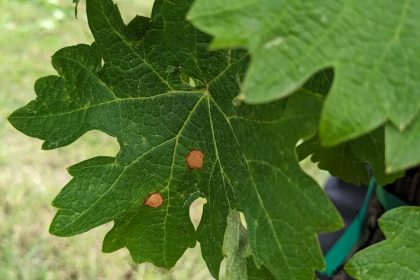Recent cooler weather seems to have slowed down vine development, but it looks like vines in the south are about to bloom. Bloom is a start of the critical time for cluster infections by downy mildew, powdery mildew, black rot, Botrytis, and ripe rot, because pathogens of these diseases can infect flower parts and develop symptoms later.
What I recommend often is the use of protective materials to protect tissues for 4-6 weeks for V. vinifera varieties, and 3-4 weeks for V. labrusca varieties, which should translate into 3-4 sprays for V. vinifera, and 2-3 sprays for V. labrusca. If you have hybrids, they are somewhere in between, so, 4-5 weeks to be protected. As usual, please make sure to rotate mode of action (= FRAC) groups.
Since we have not seen many rain events, I think powdery mildew will be the primary target for many of us. But please check your local weather to make sure, some downy mildew susceptible cultivars may still show downy mildew, especially, if there are many days with morning dews, which encourage downy mildew pathogen to produce spores. Moreover, there is a chance of rain in the next week’s weather forecast.
Below is a list of materials for each disease. Please consider your specific situations (site, cultivar, history of diseases, recent weather, weather forecast, etc., before making your decisions). In general, it is much easier and more efficient in terms of cost and also the environmental impact to protect your vines than trying to rescue diseased vines. Do not wait until you see diseases!
Powdery mildew: Sulfur (FRAC M2) is an economical option for powdery mildew prevention. Copper (FRAC M1) is also effective against powdery mildew, but I found the copper formulation I used was slightly less effective than sulfur. Other powdery mildew materials: DMI fungicides (e.g., Rally, Elite, Mettle, Rhyme, Ceyva, etc, FRAC 3), Quintec (FRAC 13), Vivando (FRAC 50), Luna Experience (FRAC 7 + 3), Topguard EQ (FRAC 11 + 3), Aprovia (FRAC 7), Aprovia Top (FRAC 7 + 3), Miravis Prime (FRAC 7 + 12), Torino (FRAC U6), etc. Please make sure to rotate FRAC codes. Try to limit the use of a particular FRAC code to twice a season with an exception of ones that starts from M. Unfortunately, we have widespread QoI (FRAC 11, e.g., Abound, Flint, etc.) fungicide resistance powdery mildew isolates in VA, so, I would not count on the QoI material for powdery mildew management.
Downy mildew: Protective materials for downy mildew are: Mancozeb (FRAC M3) [Gavel has mancozeb + zoxamid (FRAC 22)], Captan (FRAC M4), Fixed copper (FRAC M1), Revus or Forum (FRAC 40), or Zampro (FRAC 40 + 45), or Ranman (FRAC 21)). NOTE: there are increasing cases of Revus resistant downy mildew isolates in VA. Plus, resistance to Ranman is known among downy mildew pathogens of other crops. Make sure to spray before the rain and rotate the FRAC codes!
Black rot: Protective materials for black rot are: Mancozeb, QoI (FRAC 11, Aboud, Flint, Pristine, Intuity, etc.), and DMI (FRAC 3, tebuconazole, Elite, Rally, etc). NOTE: Captan and copper won’t work against black rot.
Kick-back materials for downy mildew and black rot: We do have materials with kick-back activities against downy (Ridomil products (FRAC 4), phosphite (FRAC P07, Prophyt, Phostrol, etc.), and black rot (myclobutanil (FRAC 3, DMI), etc.). However, they can be effective between infection and establishment of the pathogen (i.e., you should spray within 3-4 days after the rain). We do not have any eradicant that can kill already established pathogens. Infection on flowers and young fruits can happen very fast. Thus, rather than relying on the kick-back action, it is better to protect the vines.
Botrytis: The development of Botrytis depends on what type of varieties you grow, as well as your canopy management strategies. White-fruited varieties with tight cluster architecture tend to be more prone to Botrytis. I.e., a red-fruited variety with loose clusters probably has fewer issues with Botrytis, especially if the canopy is well maintained. Since Botrytis pathogen likes high humidity, a poorly managed canopy that traps humidity will help them to thrive.
Bloom time is important for Botrytis management because this fungus can infect flower and flower debris, and come back later when berries are maturing. There is a number of Botrytis materials such as Rovral and Meteor (FRAC 2), Elevate (FRAC 17), Vanguard and Scala (FRAC 9), Luna Experience (FRAC 7+3), Kenja (FRAC 7), Miravis Prime (FRAC 7 + 12) Switch (FRAC 9 + 12), etc. As with powdery mildew, QoI fungicides are no longer the best material for us due to the development of QoI-resistant Botrytis isolates throughout VA.
Ripe rot: Mancozeb, ziram (FRAC M3), captan (FRAC M4), and QoI (Strobilurin, FRAC 11) fungicides are currently recommended. But due to the 66-day PHI of mancozeb, you may not have enough days remained to spray mancozeb at this time of the season. Based on our lab and field tests, mancozeb, captan, copper (FRAC M1), tebuconazole (FRAC 3), azoxystrobin (FRAC 11), and Switch (FRAC 9 + 12) provided some level of efficacy against ripe rot pathogens; however, none of the products provided sufficient degree of control by itself. Also, some of the isolates causing ripe rot are not sensitive to some of those materials. Thus, when it comes to ripe rot management, please think of not only a rotation of modes of action, but also a tank mix of at least two modes of action. The timing of the application will be similar to that of Botrytis: bloom, bunch closure, and veraison.
Last, but not least, we will have a monthly viticulture meeting this Wednesday (the 20th) from noon. If you can make it to the meeting, please register using the link below.
https://virginiatech.zoom.us/meeting/register/tZYqf-6uqDwtGNHtL-cA6v4_0oOTVq6SsVv-
I hope to see you this Wednesday!


